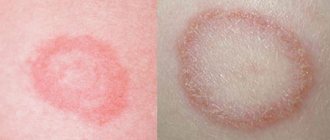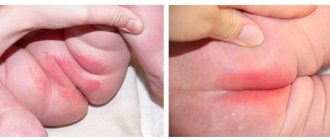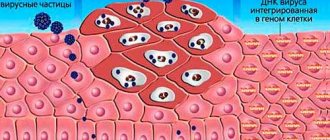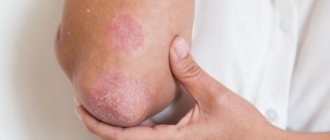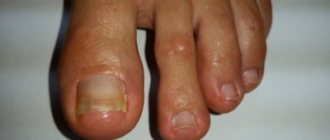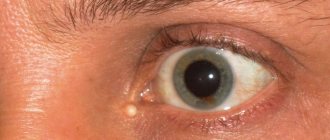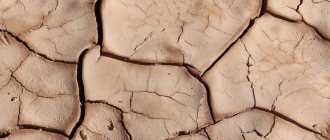- Published by: Laima Jansons
All causes and factors for the appearance of red spots on the nose can be divided into two groups - local and general .
The first group includes phenomena that provoke a rush of blood to the face , peeling, drying of the skin, irritation or hypothermia.
Common causes must be sought within; they only appear on the face, but the root of the problem lies much deeper. Since the skin is an indicator of internal processes, the location of the red spots can tell in which organ the disorder is occurring.
Red spots on the tip of the nose appear quite often and can be single or multiple , appearing on other parts of the face.
Causes and risk factors
The following factors contribute to the appearance of red spots on the nose :
- increased physical activity;
- stressful situations and nervous tension;
- treatment with certain medications;
- increased blood pressure;
- sudden changes in temperature.
The listed factors contribute to a rush of blood , due to which the most vulnerable areas on the nose are highlighted.
An equally common cause of red spots is hypothermia.
Photo 1: Allergies to foods, pollen, animal dander, medications and some cosmetics can also contribute to a red nose. With allergies, red spots on the nose will be accompanied by flaking of the skin and general symptoms, including itching, sneezing, and swelling of the skin. Source: flickr (New Suit).
Spots on the tip of the nose
A round red spot on the tip of the nose should be associated with the condition of the cardiovascular system. Such a symptom may indicate heart problems, impaired venous circulation, increased blood pressure and other pathologies. Spots on the tip of the nose may also indicate an infectious disease.
Important! The defect resolves on its own during treatment of the underlying pathology.
If red spots remain and bring more and more discomfort over time , chronic diseases and negative external factors that regularly affect the skin should be considered.
How to get rid of wine stains?
Until quite recently, port-wine stains were either not treated, or doctors resorted to surgery (skin grafting) - a very traumatic and dangerous procedure, since if the stain was tumorous in nature, its remaining cells could transform into malignant ones.
It is important to understand that several forms of nevus of the most diverse origin can exist on the skin of the same person. If you were manipulated to remove one port-wine stain, then other formations on the body may have a different origin; they should be studied separately.
When contacting about a nevus formation, the diagnostic process begins with an examination. The doctor records the size of the spot, its shape, accurately describes the location of port-wine stains, the participation of hair follicles in the process, and much more. If difficulties arise in diagnosis, a number of additional studies are carried out.
Why red spots don't go away
Red, swollen spots on the tip and sides of the nose can be a constant occurrence, disappearing for several hours or days and appearing again.
Constant exposure to allergens
Any allergen can be a potential irritant; an allergist will help identify it by conducting the necessary research . Associated symptoms, lacrimation, rash on the face, and burning of the mucous membrane may indicate an allergy .
Demodicosis
This is the most common cause of spots on the tip of the nose and in the mouth area. Demodex are mites that can be found in feather pillows. Treatment for this disease is usually long and complex . Almost every person has the parasite, the causative agent of demodicosis, but if symptoms of its infection appear, this indicates a decrease in the body’s defenses, therefore treatment is primarily aimed at strengthening the immune system and eliminating risk factors .
Frequent weather changes
In some cases , a “cold allergy” can be observed; this is not dangerous and the symptoms gradually go away on their own . You can protect your nose with high-quality nourishing creams, which should be applied before leaving the house in cold weather.
Fungal infection
Rash and spots on the nose with accompanying itching may indicate the development of candidiasis. In this case , the skin will peel and itch , and then you need to consult a dermatologist.
Frequent worries and stress
The skin instantly reacts to changes in lifestyle . A stressful situation can be not only an incident that caused a strong shock, but also a change in climatic conditions, nutrition, or taking certain medications.
Diagnosis of a spot on the skin with a red rim
For diagnosis, a general examination of the skin , anamnesis collection, examination of scrapings from the lesion under a microscope, and examination of the material using a Wood's lamp are performed. In case of severe disease, the doctor may recommend bacteriological examination (culture) of material obtained from the affected areas.
Important! In all cases, consultation with a specialist doctor is necessary! Making a diagnosis yourself is dangerous and has consequences for your health.
Accompanying illnesses
By searching for the cause of the appearance of red spots on the nose, you can make an unpleasant discovery and identify a hidden chronic disease .
Red spots on the tip of the nose and on the sides may accompany the following disorders:
- disruption of hormonal balance due to thyroid pathology;
- renal failure;
- pathologies of the gastrointestinal tract;
- gastritis or peptic ulcer of the stomach and duodenum;
- gallbladder diseases;
- pathology of the cardiovascular system;
- chronic foci of infection in any organ.
Important! When such diseases are detected, complex treatment is prescribed.
Photo 2: The specialist’s task will be to select the right medications, and at home you should review your cosmetics, change your diet and supplement your skin care with nourishing masks and other medicinal products. Source: flickr (Zoryana Ivchenko).
Vascular
The group of vascular skin spots includes hyperemic, telangiectatic and hemorrhagic.
Hyperemic
Hyperemic (from the word “hyperemia” - oversaturation with blood) spots can be inflammatory and non-inflammatory.
Inflammatory hyperemic spots
on the skin they are distinguished by their ability to temporarily dilate blood vessels in the dermis. Expansion leads to a change in the color of the spot. If you press on an inflammatory spot on the skin, this area will change color due to compression of the blood vessels. The color will become more intense or, conversely, the stain will completely disappear for a while, and will appear again after the end of the pressure. After inflammatory spots, the places where they appear may become covered with scales, change color, or disappear without a trace. Inflammatory skin spots are divided by size into roseola (spots not exceeding 2 centimeters in diameter) and erythema (2 cm in diameter or more).
Non-inflammatory spots
on the skin are characterized by the absence of inflammation, swelling and peeling. Such spots can form due to the dilation of blood vessels during emotional reactions. They most often appear on the face, neck, chest with large pink, pinkish-bluish areas. Non-inflammatory spots on the skin, in accordance with the feelings that caused them, are called erythema of anger, embarrassment or shyness.
Telangiectatic spots
Telangiectatic spots (telangiectasia - spider veins) occur in areas of the skin where blood vessels do not develop properly. The appearance of telangiectatic spots on the skin is caused by short-term or persistent dilation of blood vessels. Telangiectatic spots are divided into congenital and acquired. The cause of acquired telangiectatic spots on the skin may be the action of the sun or frost, neuroreflex excitation during puberty in adolescents, or great physical effort.
Hemorrhagic spots
Hemorrhagic spots on the skin are the result of hemorrhages (hemorrhage - hemorrhage), when blood from the vessels enters the skin tissue. At first, the color of the spots is red, gradually turning blue, then turning into green and yellow. The spots usually disappear after one or two weeks. With inflammatory hemorrhagic lesions, necrosis or increased permeability occurs in the vessels. Non-inflammatory damage to the integrity of blood vessels occurs as a result of bruises, toxic or mechanical influences. The size of hemorrhagic spots on the skin can vary:
- pinpoint hemorrhages - petichiae;
- hemorrhage up to 2 cm in size - purpura;
- a value of 2 cm or more - ecchymosis;
- linear hemorrhages;
- significant bruising.
What you can do yourself
An approximate action plan aimed at eliminating red spots on the nose:
- examination by a doctor to identify the root cause;
- following the recommendations of a specialist, taking prescribed medications;
- elimination of negative factors (smoking, hypothermia, skin injuries);
- eliminating excessive exposure to ultraviolet radiation;
- normalization of indoor humidity;
- inclusion of light foods in the diet to normalize digestion;
- changes in cosmetic preparations;
- switching to natural and healthy homemade recipes for skin care;
- proper skin cleansing using a scrub;
- daily makeup removal with alcohol-free liquid;
- using moisturizer;
- taking multivitamin complexes.
An integrated approach will help improve facial skin and eliminate the main defect in the form of red spots on the nose. You need to select products and techniques for home care individually . In some cases, scrubs are contraindicated, but for most it is an effective way to get rid of epithelial contamination and prevent the appearance of spots.
Methods for treating port-wine stains
In the past, methods such as radiotherapy, cryotherapy and sclerotherapy were used to treat port-wine stains. Not only did they not produce results, but they also left scars.
Laser therapy is the most effective way to treat this skin pathology. The Altermed clinic uses the latest developments in medical technology, based on the principle of selective exposure of the laser beam to blood vessels. As a result, the surrounding tissues around the spot remain intact, there is no risk of scars, burns or other complications, and the skin in the area of the nevus acquires a normal color.
To completely get rid of a wine stain, several procedures are necessary. The result depends on its size: the larger the spot, the lower the percentage of effectiveness, i.e. the skin just brightens. Meanwhile, during the session, tissue nutrition, blood microcirculation improves, and oxygen saturation increases. It is especially worth noting that, as scientific and clinical studies have confirmed, the number of complications and treatment time using laser light are reduced by 30%.
If you are faced with such an unpleasant problem as port-wine stains, you should not delay, because the sooner you start treatment, the more effective it will be. At the Altermed clinic we will help resolve this issue as quickly and efficiently as possible: highly qualified specialists using the latest medical equipment work real miracles!
Homeopathic treatment
Homeopathy has in its arsenal the following symptomatic medicines that eliminate red spots on the nose:
| Drugs | Symptoms |
| Sepia | Red, yellow-brown spots on the face. |
| Sulfur | Age-related pigmentation and local red spots. |
| Acidum nitricum | Fungal skin disease, brown and red spots. |
| Curare | Yellow-brown, bright red rash. |
| Phosphorus | Red and blue spots without clear boundaries. |
| Kalium bromatum | Large purple areas on the skin, a rash on the nose with a crust, purulent rashes. |
| Berberis vulgaris | Pigment spots on the nose. |
| Juglans cinerea | A red rash similar to flea bites. |
| Wine minor (Vinca minor) | Local rash on the tip of the nose, redness in different areas of the face. |
| Ptelea trifoliata | Spots of different sizes on the nose, chin and forehead. |
These drugs attack the underlying cause of the defect . At the same time, they normalize digestion, kidney and liver function , which directly affects the condition of the facial skin.
Types of stains with photos
For differential diagnosis of diseases, it is important to consider:
- localization and intensity of rashes;
- is there local itching, peeling;
- presence of local hyperthermia;
- condition of regional lymph nodes.
The following types of spots with a rim on the skin are distinguished::
A white spot with a red rim indicates low levels of melanin pigment. Such spots may be of a genetic nature or develop due to systemic disorders in the body.- Red with whitish borders is a symptom of allergic dermatitis or skin lesions.
- Pink with a red border occurs in a number of different diseases (mycoses, pseudomycosis, dermatitis).
Information for fashionistas who take care of their appearance: botox for hair, lamination, benefits and harms of procedures.
